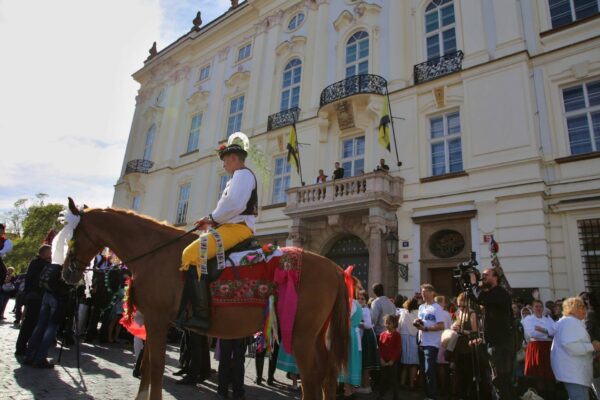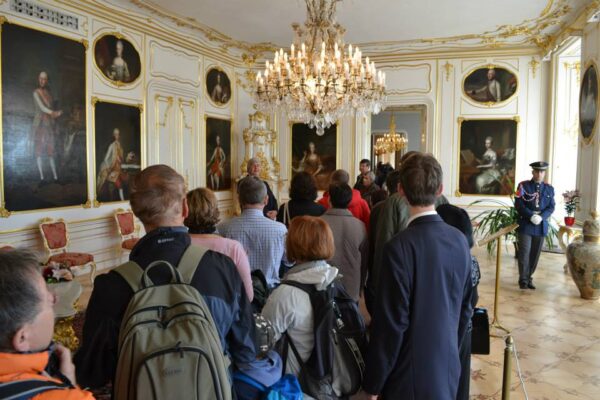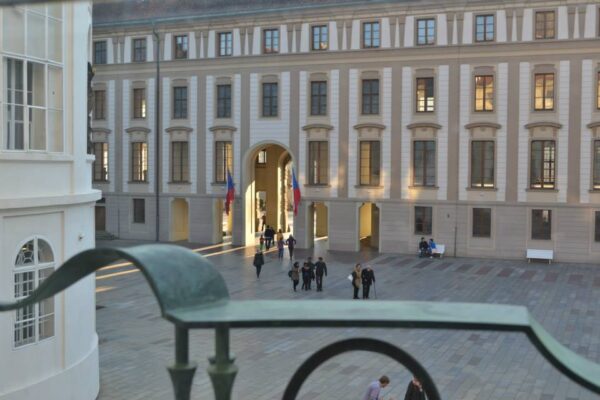Prague Castle complex
The Prague Castle complex must be at the top of your list. Right in front of Salm’s Palace entrance, on the north side of Hradcany Square is another architectonic jewel which unfortunately is not open to the public.
The white cream rococo style building, Archbishop’s Palace 1562 is the headquarters of the Catholic Church in Prague today. Prague bishops first resided in a house at the Castle, near St. Vitus, the so-called Old Provost House, which is to a great extent preserved in the original condition.
Bishops and archbishops then moved their seats to the so-called Bishop’s Court in Malá Strana, an extensive building from the mid-13th century, situated north of the stone Judith Bridge; the location is occupied by the Ministry of Finance nowadays. This edifice was so luxurious that even King Wenceslaus was jealous of its splendor.


The house was burnt and destroyed in the Hussite Wars & the office was not filled until 140 years later, Emperor Ferdinand I donated the house situated near Prague Castle to the new Archbishop of Prague who had it rebuilt in Renaissance style. It was later rebuilt in Baroque style until at the end of the 1700’s it acquired its last makeover in Rococo style.
Through a narrow and almost hidden passage next to Archbishop’s Palace, just a few steps from the entrance to the Prague Castle is another wrongfully underestimated tourist Palace/Museum that has lots to offer. The High Baroque Sternberg Palace (Šternberský palác) was built between 1697 and 1708 for Count Wenceslas Adalbert of Sternberg. In 1816 the Palace passed under the ownership of the Society of Patriotic Friends of the Arts which used it as their gallery, in one of the first-ever exhibitions of the National Gallery.
Its grandiose inner staircase, Its beautiful ceiling frescos, and its antique cabinets can only supplement the masterpieces this museum has on display. Works by Rubens, Rembrandt, Goya, Tintoretto, El Greco, van Dyck, Jan I and Pieter II Brueghel and Albrecht Durer adorn the walls of this beautiful palace and are certainly enough to make you pay a visit.
Back to Prague Castle’s main entrance gate and after you pass through its bulky square columns bearing the sculptures of the two fighting giants, you enter the First Courtyard of the Palace known as the Square of Honor. At its eastern side, facing you after you pass the main gate is the famous Matthias Gate.

The triumphal entrance gate to the Castle is named after Emperor Matthias who had it built in 1614. It is the first ever Baroque structure in the city of Prague and leads to a large staircase which in its turn leads to the most important of all the parts of the Castle complex aka Hrad (Prague Castle) or just Hrad. This part is unfortunately not open to the public but twice a year, on May 8th, at the anniversary of liberation from fascism and at the end of October at the anniversary of the independent republic of Czechoslovakia.
The State Rooms, used today to welcome official visitors of the Czech Republic, include the astonishing Habsburg, Mirror, and Music Salons, the notorious Rudolph Gallery & the impressive Spanish Hall.
in the northern wing of the New Palace, in the hall that served as Rudolph II’s, (the Czech King & Holy Roman Emperor that marked one of the brightest eras of the city, the Rudolfine era) imperial stable, is today the Prague Castle Picture Gallery (Obrazárna Pražského hradu).


The permanent exhibition on show at the Prague Castle Picture Gallery introduces visitors to a splendid collection of over one hundred prime paintings which have been carefully selected from some 4,000 in the possession of Prague Castle. Among them works of Titian, Aachen and Rubens.
During his lifetime Emperor Rudolph managed to make Prague the cultural center of Europe & amass a unique collection of 3000 valuable paintings from the 16th century.
Although only a few pieces from that collection managed to remain in the castle up to our days, many valuable paintings were added during the 17th & 19th centuries, creating an ensemble comparable to that of other major European art collections. More





